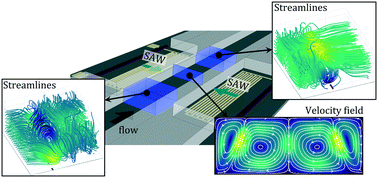On the acoustically induced fluid flow in particle separation systems employing standing surface acoustic waves – Part II†
Abstract
Particle separation using surface acoustic waves (SAWs) has been a focus of ongoing research for several years, leading to promising technologies based on Lab-on-a-Chip devices. In many of them, scattering effects of acoustic waves on suspended particles are utilized to manipulate their motion by means of the acoustic radiation force (FARF). Due to viscous damping of radiated waves within a fluid, known as the acoustic streaming effect, a superimposed fluid flow is generated, which additionally affects the trajectories of the particles by drag forces. To evaluate the influence of this acoustically induced flow on the fractionation of suspended particles, the present study gives a deep insight into the pattern and scaling of the resulting vortex structures by quantitative three-dimensional, three component (3D3C) velocity measurements. Following the analysis of translationally invariant structures at the center of a pseudo-standing surface acoustic wave (sSAW) in Part I, the focus in Part II turns to the outer regions of acoustic actuation. The impact of key parameters on the formation of the outer vortices, such as the wavelength of the SAW λSAW, the channel height H and electrical power Pel, is investigated with respect to the design of corresponding separation systems. As a result of large gradients in the acoustic fields, broadly extended vortices are formed, which can cause a lateral displacement of particles and are thus essential for a holistic analysis of the flow phenomena. The interaction with an externally imposed main flow reveals local recirculation regions, while the extent of the vortices is quantified based on the displacement of the main flow.



 Please wait while we load your content...
Please wait while we load your content...